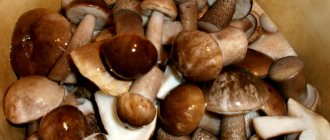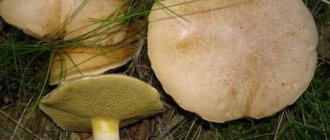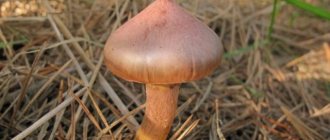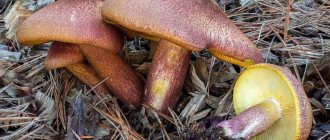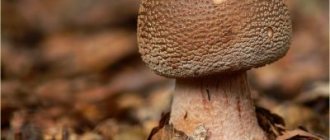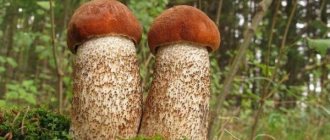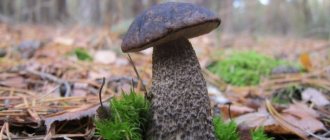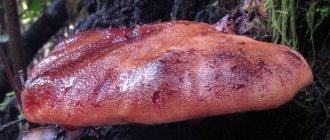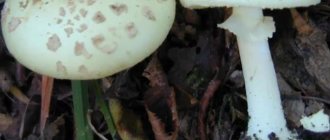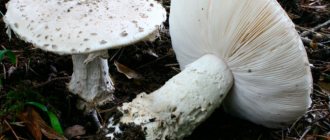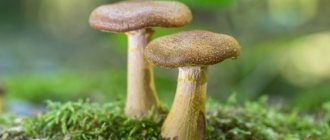2008.19
Author: Alla
Introduction:
Mushroom pickers consider boletus to be a good harvest. Although, in fact, these mushrooms are not so simple. There are 40 different types of them!
Among them there are also those that cannot be used in food under any circumstances. Based on this, it is worth understanding what can be consumed and what cannot be consumed.
Description of butter:
Butterflies prefer illuminated places. That is why they are so easy to find in open clearings. These fungi also often live in forests with coniferous trees.
They were nicknamed butterflies because they have mucus on their caps. Regardless of the shape of the top, this liquid is present everywhere.
The butterdish grows all season and it is towards the end of summer that mushroom pickers go for the harvest. After collecting, you want to taste only the collected mushrooms.
Not many people know that before cooking, the skin on the cap must be removed. Without it, the taste of the butter dish becomes more delicate.
Recognizing false oils:
Recognizing a false oiler is not difficult. To do this you need to know some differences.
- Edible boletus has a kind of film on the bottom of the cap. As the fungus grows, it becomes like a fringe
- Inedible boletus has a friability that is destroyed during the growth of the fungus.
- For false fungi, the appearance does not bode well, although at the same time edible butterflies amaze with their extraordinary beauty and pleasant smell.
- Inedible butterflies most often have dark shades on the cap and light shades under it.
Type and varieties of edible butter:
Some boletus are very similar to false ones or vice versa. Therefore, it is worth learning a little more about the most common edible species.
"White Oil Can"
These oils have three names. The oiler is white, the oiler is pale and the oiler is soft. They grow not only in coniferous forests. It is believed to be a rare species. The caps of this variety are convex and ball-shaped.
In dry weather, their yellow top is dry, but after rains mucus appears on it. The radius of the hat measures approximately 5 centimeters.
When cut, the leg most often turns red. Collection should be carried out at the initial stages of its growth.
This should be done because white oil can easily outgrow. Cooking should be carried out immediately after collection, as this product quickly deteriorates.
Popular types of edible boletus
There are several types of boletus that can be eaten; their description makes it quite possible to distinguish them in the forest:
- Yellow-brown butterwort (pied butterwort, variegated butterwort) grows in small bunches in the pine forest.
The cap reaches 14 cm in diameter and is semicircular in shape, which becomes cushion-shaped with age. In young representatives the color is olive, and in mature representatives it can be brown, red and yellow. The surface, unlike other representatives of the Maslenkovs, is not slimy and cracks into scales. As a result, the skin is difficult to separate. When immature, the surface is hairy and then turns into thin, smooth scales. The leg resembles a mace. The pulp is yellow, turns blue at the cut site. The aroma is reminiscent of metal or pine. This type is great for pickling. - White butterwort (pale) grows in small bunches in pine and cedar forests.
Fruits from June to November. The rounded cap reaches a diameter of 12 cm. The surface is slightly slimy, light yellow, with purple spots. The leg resembles a cylinder or spindle shape, reaching a height of 8 cm. The flesh is purple under the skin, light in the middle and yellow above the spores. The aroma and taste are pronounced. It is advisable to collect this species when the mushrooms are still young. - Granular oiler (summer) grows in bunches and is often found among coniferous thickets, under pine trees.
The cap is up to 10 cm in diameter, round in shape and red-brown or yellow-orange in color. The surface is dehydrated, glossy, and becomes slimy with high humidity and after rain. The skin separates freely from the pulp. The leg is light yellow with brown spots, up to 8 cm high and up to 1.5 cm in diameter, resembling a cylinder. A lumpy surface is formed after the droplets dry, which are released by the pores. The pulp is yellow, with a pleasant aroma and taste of a nut. The color does not change at the cut site. The spores are brown. - Common oiler (autumn) grows in groups and is often found in coniferous and mixed thickets. Fruits from early July to October. A hat with a round shape, brown or chocolate color. The surface is covered with mucus, and the skin is easily removed. The diameter reaches 12 cm. The color of the spores is brown. The aroma and taste are not expressive.
- Cedar oiler (weeping) mostly grows in dense clumps in cedar forests. Fruits from mid-June to the end of September. The hat can reach 15 cm in diameter and is brown in color. The surface is waxy, non-shiny, yellow. The leg is covered with rust-colored spots. The pulp is light yellow in color and turns blue when cut. The taste is sour, the aroma is inexpressive. The pores can secrete liquid, which hardens and turns the mushroom brown.
- The remarkable butterdish grows in swamps and in places with high humidity.
It can be found in North America, Siberia and the Far East. Fruits from early summer to late autumn. The hat is fleshy, measuring from 10 to 15 cm. The surface is mucous with minor scales. Leg with a ring. The color above the ring is light yellow, below it is brown with slight scales. After cutting, the flesh is first yellow, then turns brown. The aroma and taste are weakly expressed. - The red-red oiler (Tridentine) grows on mountain slopes and in coniferous thickets. Fruits from early summer to late October. The cap is fleshy, orange, semicircular, which eventually becomes cushion-shaped. The flesh is fleshy, yellow, and turns red when cut. The color of the spores is olive.
Oiler red-red - Siberian butterwort grows in frequent groups in pine forests. The cap is light (but darkens with age), reminiscent of a hemisphere, which soon unfolds in adulthood. The skin becomes slimy with high humidity and is easily peeled. Drops may be released that harden into brown spots.
"Ordinary oiler"
This oiler also has several names. They are called yellow, late, true or autumn.
They prefer pine trees, but can also grow near birch trees. These mushrooms live easily without sunlight. Because of this, they are easy to find on forest edges.
An ordinary oiler has a round cap. When the mushroom is overripe, it becomes brown and flat. The top is slimy to the touch.
The butterdish grows in July until the cold weather strikes. The leg is small, cylindrical and on average 5 centimeters in length.
This variety will grow several pieces near other species. For example, not far from white boletuses or chanterelles. Only grown mushrooms are considered the most delicious.
False and poisonous doubles
In the Maslenaceae family, both false inedible and poisonous boletus mushrooms and conditionally edible mushrooms are distinguished. They can be easily distinguished:
- The false ones include the pepper flywheel of the genus Chalciporus. The fruiting period is June-October. The hat is round, smooth, glossy. The height of the leg is 6 cm, and the diameter is 1 cm. It turns red when cut. The main distinguishing feature of the mushroom is its peppery taste, which disappears after heat treatment. Many chefs consider it inedible, however, some cooks add it to food for flavor.
Pepper moss - The poisonous satanic mushroom (satanic bolete) grows in oak and deciduous forests on calcareous soil. The cap is 20 cm in diameter, cushion-shaped, light olive, fleshy in structure. The flesh of the poisonous twin is light and turns blue when cut. The smell is unpleasant and reminiscent of carrion, especially pronounced in mature mushrooms.
Satanic pain
Mushrooms that look like boletus turn blue when cut when peeled, why, photo
Why boletus and similar mushrooms turn blue when cut when peeled: reasons
Mushroom poisoning is a rather annoying phenomenon, and in most cases it is fatally unsafe. This is actually why many, even qualified mushroom pickers, are suspicious of any original phenomena that are associated with their collection. One of these phenomena is the bluing of the site of damage or fracture of the fruiting bodies. Very often, boletus-like mushrooms turn blue when cut. Next we will consider whether this is considered the norm and whether it poses a danger to the mushroom picker.
Do boletus turn blue when cut?
The question of whether oilcans can turn blue in places of damage worries many mushroom pickers. But, in general, a change in the color of the fruiting body when damaged is inherent in virtually all representatives of the mushroom kingdom, without exception. It’s just that in many species it is virtually invisible, in others the color may be slightly different, and in others (especially representatives of the Boletaceae family) it can occur very strongly.
Below is a photo illustrating this phenomenon:
Why do boletus turn blue when cut?
The basis for the change in color of the stem or cap when damaged (it does not matter whether it is a cut or the result of cleaning) is considered to be an oxidative chemical. the reaction of the juices of the fruiting body and the oxygen contained in the air.
The cut breaks the tightness of the stem, and the juices react with atmospheric oxygen. This property is characteristic of all mushrooms without exception.
What varieties of butternut squash turn blue when cut?
There are several types of Maslenkov, the place of damage of which turns blue:
- Larch gray or bluish. Its characteristic feature is its almost flat cap. Its surface is light brown. The stem should turn blue after cutting, which is reflected in its name. Still, it belongs to edible (albeit category 3), it is often eaten in salted form.
- Yellow-brown. His hat is the right color. It is classified as inedible, although not toxic.
- Peppery. It differs from ordinary representatives of Boletaceae by the absence of a ring and a reddish hymenophore. Also conditionally edible, but non-poisonous. Due to its immensely pungent taste, it is used infrequently as an additive, similar in effect to spices.
What other mushroom that looks like an oil can turns blue when cut?
Not only mushrooms such as boletus turn blue when cut. There are several types that also have a similar property:
- The bruise is normal. Belongs to the genus Giroporus of the Boletaceae family. It has a large cap with a diameter of more than 15 cm. The stem is white, the cap is beige.
- Moss fly is yellow-brown. Conditionally edible, similar in appearance to the Maslenkovs. If the color change occurred almost immediately after the break, it is most likely a flywheel. A characteristic feature is that the cap is quite thick. Moreover, when cooked, this species turns all its “neighbors” red.
- Dubovik. A large olive-brown representative of the boletus genus. Found mainly in oak groves.
- Polish mushroom. Also a representative of boletus. Quite large, has a large and fleshy hemispherical cap. It is very tasty, almost a gourmet dish. It is found in both coniferous and deciduous forests.
- Ryzhik. Also refers to the “blue” ones, but there is no doubt about its edibility.
- Hell's mushroom. It has a squat and thick body with a red leg and a white cap. It changes color at the site of damage, but it is difficult to confuse it with any edible representative due to its distinctive appearance.
As can be seen from the description, a change in color at the site of damage is characteristic of a fairly large number of very different species, and there is nothing dangerous in this phenomenon.
Should I worry if the butterfly mushroom turns blue when cut?
If boreal oils turn blue, there is no danger in this. This property is distinctive not only for representatives of this genus, but also for many others, having the most diverse origins and growth conditions.
Conclusion
The phenomenon when butter mushrooms turn blue when cut is considered normal and real. This is an ordinary reaction of the mutual action of mushroom juice and oxygen. This phenomenon cannot be attributed to a sign of toxicity, because it is inherent in representatives of all kinds of genera of the mushroom kingdom. If the oiler changes color during collection or cleaning, there is no need to throw it away and wash the instrument. If a given specimen has been definitely identified as edible, it can safely be eaten.
How and what to cook from moss mushrooms?
When starting to process the collected flywheels, you need to remember that in their purified form they darken when exposed to air. That is why they need to be immersed in water with citric acid dissolved in it (2 g per liter) and salt (teaspoon per liter).
Moss mushroom goes well with meat, chicken, cabbage, pumpkin, and cream.
Popular dishes made from these mushrooms are:
Marinated moss mushrooms
Mushrooms must be thoroughly cleaned and washed. Place in a deep saucepan, add water, and put on fire until it boils. Boil for 15 minutes over low heat, discard the mushrooms in a colander.
While the water is draining, prepare the marinade. To do this, pour a tablespoon of sugar and salt into a liter of water, add 2 bay leaves, a couple of cloves of garlic and a little cloves. Put on fire, let it boil, add a tablespoon of vinegar.
Without turning off the heat, add the mushrooms to the marinade and simmer for 5 minutes. Place mushrooms in sterilized jars. The liquid should cover the mushrooms. Roll up the cans. Store pickled mushrooms in a cool place.
Stewed moss mushrooms
To prepare this aromatic dish, take a kilogram of mushrooms, an onion, and 200 g of sour cream. Boil the mushrooms in a thick-bottomed bowl for 1.5 hours, then fry.
A few minutes before the mushrooms are ready, add chopped onion, salt and pepper. After this, add sour cream and a little water to the mushrooms.
When the sauce thickens, the dish is ready. It can be served as a sauce for cereals or pasta.
Fried mushrooms for the winter
This is a preparation that differs from the usual pickled or salted mushrooms. To prepare, you need to take a kilogram of moss mushrooms, 250 ml of vegetable oil, salt and pepper to taste.
Peel and wash the mushrooms, boil them 2 times for 15 minutes, changing the water after each time and washing them again. Heat a frying pan with vegetable oil, place chopped mushrooms in it, cover with a lid and simmer for half an hour. After this, remove the lid and simmer for another 15 minutes until the liquid has completely evaporated, add salt and pepper.
Place the prepared mushrooms in sterilized jars, pour the remaining oil from frying on top 2 cm, and roll up. Store moss mushrooms prepared in this way for 6 months.
Moss mushrooms with honey
This is a very unusual dish with a pleasant sweet and sour taste. To prepare you need 1.5 kg of mushrooms, 2 tablespoons of honey, 2 cloves of garlic, 2 tablespoons of mustard and the same amount of vinegar, 50 g of vegetable oil, parsley.
You need to peel and wash the flywheels and cut them into cubes. Chop the greens, pass the garlic through a press, add honey, vinegar, mustard and chopped mushrooms. Mix everything thoroughly, put in the refrigerator, let stand for 3 hours.
Heat vegetable oil in a frying pan, add the whole mixture along with the marinade. Simmer over low heat for 45 minutes. This dish goes well with boiled potatoes.
Mushroom soup
You can cook it with either meat broth or vegetables. Process mushrooms (300 g), trim the stems. Chop the moss mushrooms. Peel and chop an onion and 3 potatoes, a bunch of green onions.
Fry the mushrooms for 8-10 minutes, then add the onion to them, fry for another 4-5 minutes. Place the contents of the frying pan into boiling water or broth, add salt, add 2 tablespoons of pearl barley, and cook for 10 minutes over medium heat. After this, add potatoes to all the ingredients and cook for 15 minutes.
Next, add the chopped herbs, turn off the heat, and let the soup simmer, covered, for 10 minutes. Serve with sour cream.
Salad with moss mushrooms
To prepare the salad, you need to take 3-4 potatoes, boil them in their skins, and cut them. Also chop an apple, 300 g of pickled mushrooms and 150 g of ham. Mix, add chopped celery and parsley. Season with vegetable oil and vinegar, add salt and ground black pepper if desired.
The flywheel mushroom is common on all continents. It is represented by several species, most of which are edible. You can prepare various dishes from moss mushrooms, as well as prepare them as canned food for the winter. It is not difficult to grow moss mushrooms yourself in your summer cottage.
Symptoms and first aid for poisoning with false boletus
The first signs of poisoning can be noticed after 3 hours. This is usually expressed as an eating disorder. Initially, you feel severe pain in the stomach and the urge to vomit. The stool is loose and frequent. Sometimes accompanied by fever and headache. The amount of oil consumed and the individual perception of the body should be taken into account.
You should not wait until the patient has all the manifestations of boletus poisoning - emergency medical care should be provided immediately. You need to call your doctor immediately. In addition, it is important to help the person independently - give a large amount of warm water with activated carbon dissolved in it. This will help cleanse the stomach and intestines of toxic substances.
It is quite possible to be poisoned by false boletus. If you do not know where the mushroom came from, where and who picked it, then it is better to refuse to eat it.
Remember!
If the mushroom is thermally treated correctly, even conditionally inedible boletus can be made edible.
Processing mushrooms after harvesting
Butterflies are mushrooms that have a pleasant aroma and taste. But if the heat treatment was carried out incorrectly, this wealth can be lost. How to properly prepare mushrooms for processing? First of all, you need to sort them out, determine the type, and make sure that no poisonous mushroom is in the basket. And only then start cleaning. This must be done immediately as soon as they are brought from the forest. Otherwise, they quickly deteriorate, and insect larvae, comfortably located in the mushrooms, play an important role in this.
The skin is removed, but only from those species where it can be easily separated. Experts believe that consumption with the skin can lead to digestive upset. But many mushroom pickers, sharing their experience, claim that a mushroom cleaned in this way is more attractive than a specimen with a dark cap.
After the mushrooms are cleaned and sorted, you need to rinse thoroughly several times. It is best to fill the butter with cold water. This will preserve their smell. Then chop the mushrooms and rinse again. Be sure to let the water drain. Do not soak the fruiting bodies for a long time. They absorb water like a sponge, and then they are difficult to clean, cut, and their taste after this leaves much to be desired. Then you can proceed to heat treatment or other harvesting methods.
Butterflies are almost universal mushrooms. They can be dried, fried, boiled, cooked in soups and caviar, pickled and salted.
What mushrooms turn blue when cut?
Scientists have identified mushrooms, which have a huge variety of species: edible and poisonous, as a separate kingdom of living nature. This article will discuss why and which mushrooms turn blue when cut.
Blue milk mushroom
This mushroom is distributed throughout our country, but prefers to grow in the forests of Siberia and the Urals. Many residents of foreign countries consider it inedible, but this is not so. It’s just that the cooking technology causes a lot of trouble. This mushroom has many names: purple, blue, lilac, dog.
Many edible mushrooms turn blue when cut. A typical representative is the blue milk mushroom. Its cap reaches a diameter of fifteen centimeters and is yellow in color. If you cut or press on a mushroom, it turns blue. Hence the name. The cap of young milk mushrooms is slightly convex, but as they grow and age, it becomes spread out or depressed. Blue milk mushrooms are mushrooms that turn blue when cut. The photo clearly demonstrates this. The mushroom is distinguished by dense and thick pulp, which can be yellow, light brown or cream in color. When interacting with air, the white juice turns purple.
This mushroom has no doubles. Mid-August - early September is the best time to collect blue mushrooms, which are rich in mixed and coniferous forests. They hide under birch and spruce trees. These milk mushrooms are fried or boiled. They are not pickled, as both the mushrooms and the liquid turn blue.
Mushroom - bruise
It got its name for a special property: when cut, its flesh changes color from white to bright blue. If the mushroom looks like a white mushroom and turns blue when cut, this is a bruise. The appearance of these two varieties is very difficult to distinguish. The bruise mushroom is extremely rare, so information about it can be found in the Red Book.
The diameter of its cap reaches 15 cm. In a young mushroom it is convex, and in an adult it is spread out. You can see subtle cracks on the brown or yellowish cap. Mushrooms turn blue when cut when touched and pressed. Therefore, they cannot be confused with poisonous mushrooms, which lack this ability. Under the cap there are yellow spores and tubes that instantly turn blue at the slightest impact on them. The leg is dense, tuberous in shape. Its structure is gradually being destroyed. In an aging mushroom it is hollow.
Harm and contraindications
Butterfly contains many useful substances
Despite the fact that butterflies are healthy mushrooms, if improperly prepared and consumed excessively, they can cause harm. The following negative properties are currently known:
- The cap and flesh of the butter quickly absorb harmful substances from the atmosphere. If mushrooms are collected near factories, roads and other places where there is air pollution, then there is a high probability that there is a high concentration of toxins inside them. Old boletus is especially dangerous because it has taken longer to absorb harmful elements.
- Worms quickly grow in boletus, which eat the pulp and leave various waste products in it. If they enter the human body, they can cause poisoning or allergies.
- In many species of oilseed, the film can cause indigestion even after heat treatment.
- The bacterium Clostridium botulinum can live in boletus. It is almost impossible to remove it from a mushroom: it is not affected by heat treatment, and it can reproduce even in a pickled jar, where there is no oxygen and there is a high concentration of vinegar. When it enters the human body, it infects it with botulism. During the course of this disease, the functioning of the nervous system is disrupted.
- Butter is one of the hard-to-digest foods, so they should not be eaten in large quantities. They are also not recommended for use by pregnant women, children and people with digestive problems.
Interesting: Edible mushrooms - list, photo, name, description, video, when and where they grow
If after eating buttermilk you feel a heaviness in the stomach, it is better to take digestive aids.
Interesting fact : in Ancient Russia, boletus was used by healers to treat gout.
False mushrooms: differences
How to distinguish inedible mushrooms among butter mushrooms? The false one is very similar in appearance to the edible one.
However, with the naked eye, upon closer examination, several distinctive signs of false butterflies can be seen.
It is the appearance that can help determine whether it is a real oiler or not. In this case, first of all, you need to pay attention to the mushroom cap and its inner surface. The false mushroom has a light purple color, the inner side is painted a bright yellowish-cream color. And the lower part of the mushroom has a lamellar structure (spongy structure in edible ones).
False butterflies also have distinctive rings on their stems. Usually in an edible mushroom they are light purple. And the false oiler has a ring of white or light purple color, and it hangs down the stem. And, as a rule, this ring dries out very quickly, which is not observed with ordinary oils.
False boletus can also be distinguished by its pulp. In this mushroom it has a reddish tint and a spongy structure. In addition, at a cut or break, the pulp changes color over a short period of time.
The butter dish is an inedible double. Description of species
The oiler got its name from its always moist, oily cap. The butterdish has its own double, so you need to know what false butterdishes are and how to distinguish them from the real one.
Spruce weed
The false (empty) buttercup mushroom is not poisonous. Mushrooms such as false boletus are also called spruce moths.
The cap is covered with a mucous film, as in the real species. Spruce weed is a type of butterfly that differs from a real mushroom in that it belongs to the lamellar species, while boletus belongs to the tubular species. This species is not dangerous; it is often taken for salting. Mild weed poisoning occurs in people suffering from chronic diseases of the digestive organs.
The hat will not help distinguish these species, so they look at the fruiting body. A real oiler has a tubular layer of light yellow color, while in mokrukhs it is plate-like, whitish, and darkens with age. The inedible twin has a cylindrical stem that tapers downwards. At the base it is always yellow. The color of the stem of this specimen matches the cap and the entire fruiting body.
Pepper moss
It is not poisonous; it got its name for its pungent, spicy taste. Found in dry coniferous and birch forests. Outwardly it looks like real boletus. If you look closely, the differences become noticeable:
- the surface of the cap is dry, velvety, without mucous membrane;
- the leg is not whitish-grayish as in the real species, but is painted in bright reddish tones;
- There is no light film on the back of the cap.
The fruit body has a pleasant taste. With appropriate cooking, the pulp is quite edible.
It is difficult to distinguish false boletus from a photo; it is better to know exactly what they look like.
Growth periods
This variety loves moisture, which means it grows after rains, especially during the period when sunny weather sets in after a cold snap. Mushrooms ripen from June until frost. But if the summer turns out to be hot with little rain, boletus will be rare in the forest. This variety loves a temperate, mild climate and sufficient moisture.
When choosing boletus, it is worth remembering that small specimens, the diameter of which does not exceed four centimeters, are much tastier than overgrown boletus. They have a delicate texture and a sweetish taste with a pronounced mushroom aroma. It is better to leave older specimens in place, this will give them time to expel their pores, after which the number of mushrooms in the places where they grow will increase significantly.
Existing varieties of butter - characteristic features
Fungi are eukaryotic organisms that combine many of the properties of plants and animals; in Latin they are called Fungi or Mycota. They are divided according to their place of growth into meadow, steppe, mountain and forest. Oil beetles, called Suillus, of which there are more than 40 species, including both useful and conditionally edible or unsuitable for food, grow in wooded areas .
The benefits of tubular mushrooms of the Boletaceae family lie not only in their nutritional value, but also in the elements they contain, such as carbohydrates, a number of amino acids, B vitamins and lecithin. Butter also has harmful properties characteristic of all organisms of the kingdom Mycota - chitin, which has a negative effect on the gastrointestinal tract.
According to nutritional value, there are 4 categories, which differ in the amount of useful elements contained and taste. In this regard, any species of the boletus genus does not belong to the second position, that is, the usefulness and taste are quite high, but inferior to many other mushrooms. There is another gradation.
- excellent edible;
- good edible;
- conditionally edible;
- unfit for food;
- poisonous.
Fungi of the genus Suillus occupy the second and third positions, depending on the species. The fact is that false boletus is not included in this family and does not exist as a separate species. This is just the name given to some other representatives of the kingdom Mycota, which have a similar shape and color. The difference lies in the fleshy ring around the stem, which appears as it matures from the film covering the spore pockets of the young mushroom - false butterflies do not have this. Therefore, the fourth and fifth categories do not apply to Suillus.
Good mushrooms include such popular species among mushroom pickers as common butterfly (known as late, autumn), pale (or white), granular (or early), yellow-brown (or variegated, familiar to us as swamp moss). Suillus tridentinus (rufous or Tridentine), plorans (cedar or weeping), Siberian (this type is closer to the conditionally edible) and remarkable grow in Russia and Europe.
Conditionally edible, there are several types of butterfly: yellowish, larch, snork and gray. All of them are suitable for food only after thorough cleaning of outer films and long-term cooking.
Beneficial features
- the resin contained in boletus removes uric acid, relieves headaches and joint pain, and calms the nervous system;
- mushroom is a source of valuable lecithin;
- a diet based on boletus helps with depression and fatigue;
- The skin of the mushroom contains natural antibiotics that boost the immune response.
- Mushrooms contain large amounts of vitamin D, just like butter.
- In terms of vitamin B content, they are not inferior to cereals.
- Mushroom lecithin reduces cholesterol in the blood, which makes them useful for people with impaired metabolism, vascular and heart diseases.
- It is recommended to include mushrooms in the diet menu, as they are low in fatty acids, which prevent arteriosclerosis.
- They are used as an anti-cancer and stimulating agent for the human body.
- Mushroom enzymes break down fats, so they should be consumed by people who want to lose weight.
- It contains fiber in large quantities, which cleanses the stomach and improves digestion.
Mushrooms contain a lot of plant fibers and chitin, which are difficult to digest, making beneficial substances poorly absorbed. To eliminate this, the mushrooms are dried, thoroughly ground and stored in hermetically sealed jars in a dark place.
Important: table salt is added to the mushroom powder. This drug is used as a seasoning. There are many toxic and radioactive substances in the atmosphere that are absorbed by edible mushrooms
Therefore, collecting them along roads and in areas with industrial enterprises is fraught with danger to life. You should not buy mushrooms at the market, since it is not known where they were collected. Possibly in an environmentally polluted area. Don't go mushroom hunting alone. Remember, if a poisonous mushroom gets into the basket, this can lead to poisoning of all its relatives. Better get rid of the contents of the basket. Mushrooms are considered heavy food, so they should not be consumed by babies, nursing and pregnant women, and people with various diseases of the digestive tract.
We invite you to familiarize yourself with Potato zrazy with mushrooms - a step-by-step recipe for cooking in a frying pan
Mushroom season is called quiet hunting. Be careful not to let this silence make you worry. Collect only edible mushrooms!
